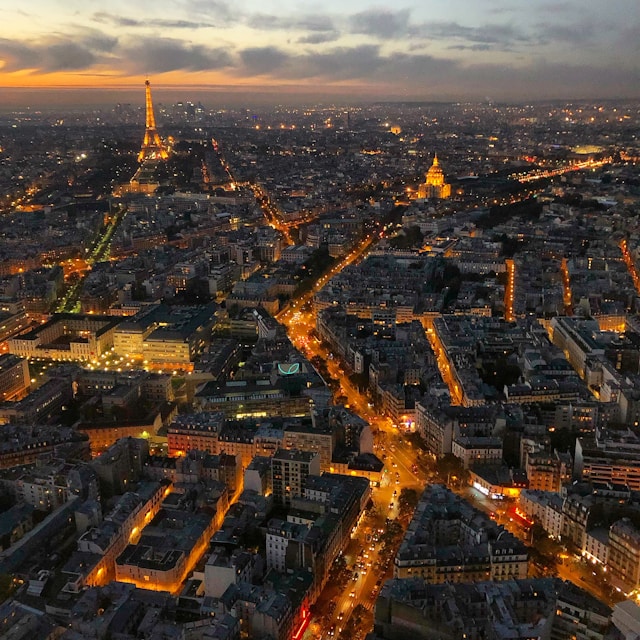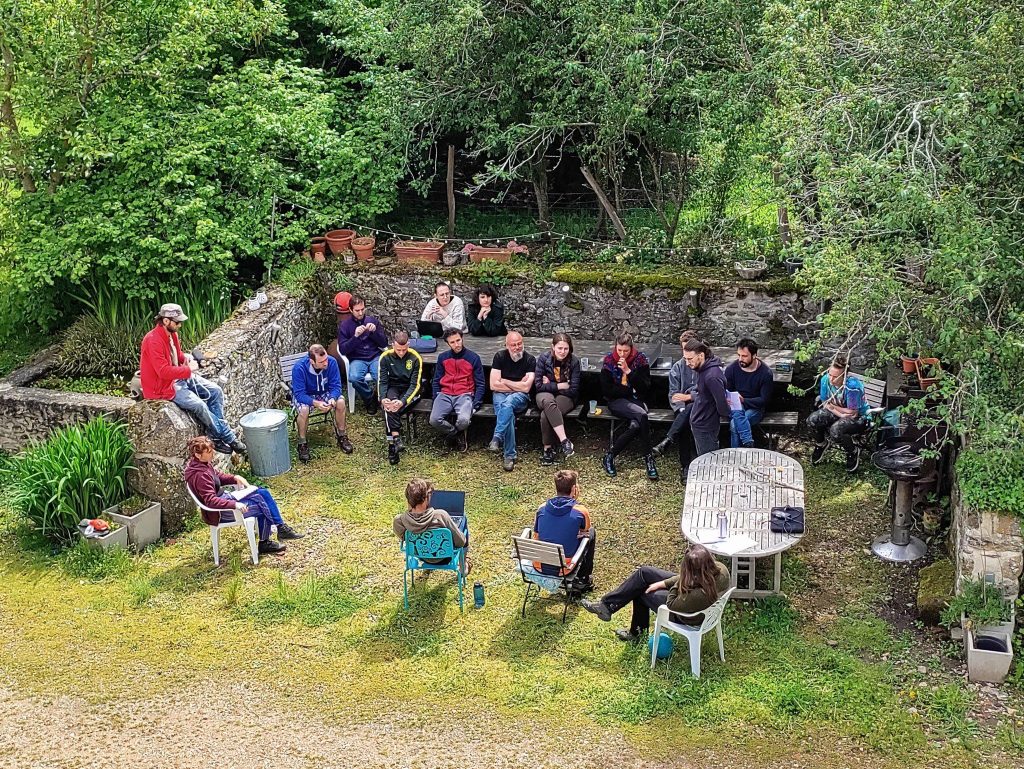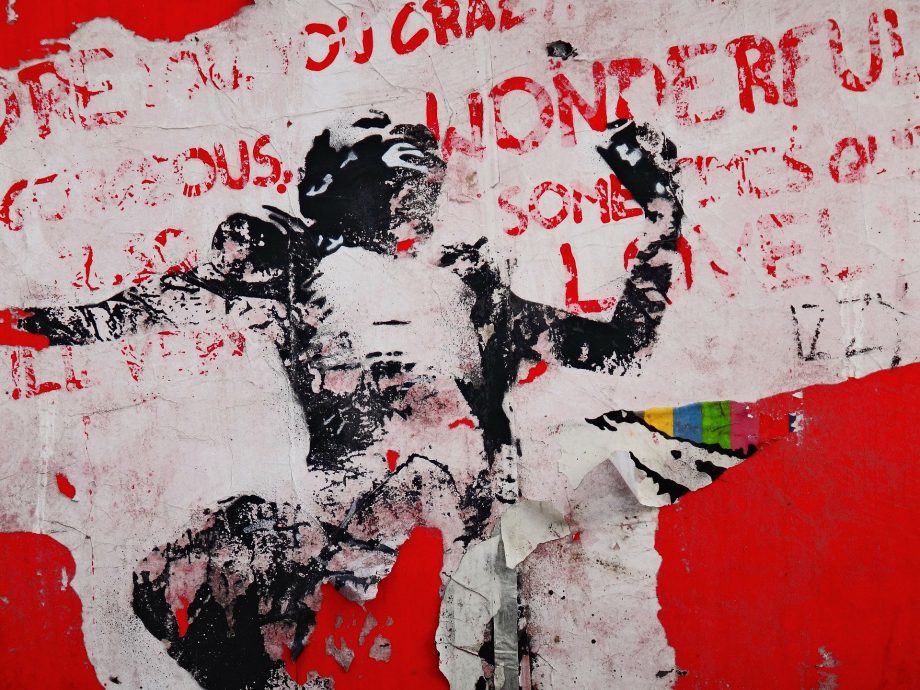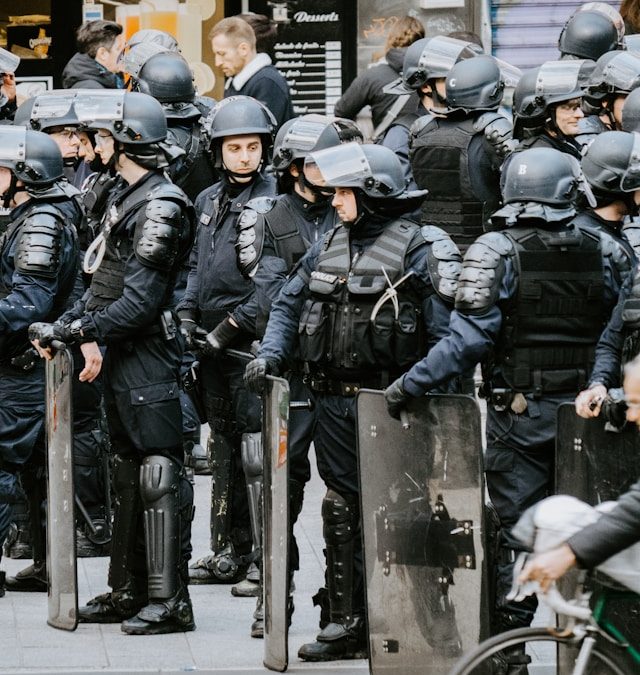
by DGR News Service | Feb 3, 2025 | ACTION, Direct Action
In response government officials labeled Earth Uprisings “eco-terrorists” — continuing a worldwide strategy of criminalizing protest.
In France, One Group Seeks to Do the Unthinkable: Unite the Climate Movement
by Anna Pujol-Mazzini, The Revelator
September 3, 2024
This story is a joint production of The Revelator and Drilled. Read more from Drilled’s series on the criminalization of protests and activism.
In France the unthinkable has happened: The working-class Yellow Vest movement, racial equity movements, and progressive climate activists have joined forces in a multiracial, cross-class coalition called Earth Uprisings. In uniting the climate movement with broader social justice causes, “Les Soulèvements de la Terre” is not just making history in France; it’s offering a blueprint for global environmental resistance. But the response has been shockingly violent and extreme.
1. The Start
On an icy day in January 2021, French climate activists gather in a wetland area in Notre-Dame-des-Landes around one depressing observation: None of their efforts have succeeded in making a real dent in the current environmental collapse.
That’s why they’re meeting. Like many other movements, they feel like they’re out of options. “The first wave of the ‘climate movement’ confronted us with this powerlessness,” some of the activists will later write in a collective book titled Premières Secousses (First Shockwaves). “From COP meetings to massive marches, from climate action camps to IPCC reports, we have not managed to significantly curb the ongoing devastation.”
So here they are, 200 of the foremost climate activists in the country. There are anti-nuclear activists; unions of smallholder farmers; and members of newer movements such as Youth for Climate or Extinction Rebellion. The room is full. Many have been holed up at home for weeks, waiting for the second Covid lockdown to lift. There are still curfews and restrictions in place, but they decide this meeting is too important.
“It’s been a year of one lockdown after the next,” an anonymous participant writes. “Residents of [Notre-Dame-des-Landes] decide to issue an invitation to an assembly called to ‘move heaven and earth’ with some concrete proposals. Little notes are sent to long-time comrades as well as to people just met… It is still forbidden to meet, but impossible not to get organized.”
They’re exhausted and desperate. They have no idea that they’re about to form the most feared climate movement of the 2020s in this country — a movement that both the government and polluting industries will dread. And a movement that could offer a blueprint for global climate resistance.
They get to work. After two days of discussions, and sometimes heated debates, they land on something new: a sort of loose coalition of local struggles across France, with a variety of actors and tactics, all acting under one banner, Les Soulèvements de la Terre. The Earth Uprisings.
Their slogan: We are the Earth defending itself.
The initial round of brainstorming produces ambitious ideas: “We must besiege Monsanto in Lyon,” “make the biggest intrusion ever carried out on a concrete plant,” “block the Yara synthetic fertilizer production terminal in the bay of Saint-Nazaire.”
Then the reality kicks in: They’ve just created a new movement, they have no idea whether it’s going to take, and actions in the past have yielded little result. They decide to test it out for six months, then come back and reassess.
But politically, their ambition is clear in the first call to action they publish a few weeks after the meeting. The focus is on three goals: taking back the land from polluting industries and intensive agriculture; ramping up tactics to include occupation and sabotage; and uniting all actors who have an interest in curbing the climate emergency. In the founding text, one of the things they emphasize is that they want to get rid of the class divide that has plagued the climate movement — not just in France but all over the world. They write: “We do not believe in a two-tiered climate activism in which a minority prides itself on eating organic and driving a hybrid SUV while the majority is stuck in jobs they don’t want to do, long daily commutes, and low-cost food. We will not accept to watch the end of the world, powerless, isolated, and locked in our homes.”
So they call to target, block, and dismantle three key industries: concrete, pesticides, and synthetic fertilizers.
2. The Basins
After months of localized struggles to save natural land from urban development projects, one issue emerges and quickly gains traction: the fight for water.
In France, to counter more and more frequent droughts partly caused by climate change, the government is helping build “mega-basins” — large aboveground pools used to pump water in groundwater tables in the winter and irrigate large-scale farms in the summer.
But pumping water makes droughts worse. And the reservoirs can only be used by a handful of large agribusinesses, which are mainly focused on cornfields and other irrigation crops for export. Activists argue that mega-basins effectively privatize water resources, sidelining small-scale, eco-friendly farmers.
“I guess it became a real realization for a lot of people, what the fight for water meant and access to water,” recounts Lea Hobson, a former Extinction Rebellion activist who now organizes with the Earth Uprisings. “I think that resonated for a lot of people. And it meant that a lot of people came from all over France.”
The campaign they launch to stop the construction of these mega-basins will radically reshape their future and the future of the French climate movement.
It will also unleash state violence against environmental activists on an unprecedented scale.
The first big protest takes place in October 2022, at the site of one of the basins in Sainte-Soline, a small village of about 600 people in western France. Thousands of activists turn up. So do hundreds of police officers, who use tear gas grenades to disperse protesters peacefully occupying the empty reservoir. Dozens are injured, and six people are arrested.
In the coming days, the public narrative of the events in Sainte-Soline becomes its own battle. Local officials say “very violent activists” wreaked havoc at the protest. Gerald Darmanin, the French minister of interior, calls the activists “eco-terrorists” — a rare term for a French government official discussing climate activists — and promises to fight them.
“This is an extremely strong word for a country which suffered deadly terror attacks in 2015, which left a lot of families in mourning,” points out Alexis Vrignon, a professor at the University of Orléans who specializes in the history of environmental conflict. “The tactics of the water protesters can be discussed in terms of ethics or effectiveness, but they are totally different” from those of terrorist groups, he adds.
According to Michel Forst, the United Nations special rapporteur on environmental defenders, the “campaigns of vilification by public officials also have a great impact, which is very unfortunate, on public opinion. When you have a minister … and members of parliament calling those people eco-terrorists or simply terrorists or comparing them to the Taliban, then it’s not only the people who are under pressure, but the cause they’re fighting for, which is also being debated.”
Despite these attacks in the media, activists reconvene in Sainte-Soline five months later. This protest is set to be bigger, more ambitious. The protesters — farmers’ unions, working-class Yellow Vests, and many other unlikely allies — arrive from all corners of France and even beyond. In a field a few miles away from the reservoirs, hundreds of brightly colored tents pop up around the protest camp.
There are also 3,000 officers on site, waiting for protesters.
“You had a lot of people who were not essentially in climate movements but heard of what was going on and so would come there … as their first big mass action,” Lea Hobson, the activist, remembers. “The diversity of people — I’ve never seen that in any actions that we’ve had in Extinction Rebellion, for example.”
On the morning of the protest, thousands start marching to one of the basins. Their goal is to stop construction, take apart some of the pipes that have already been installed, and get a moratorium on any new reservoirs being built with public funds. The march is joyous. There are families with kids, people playing accordions, dancing in their blue workers’ outfits, and huge mascots representing local species that are threatened with extinction: an eel, an otter and a type of bird called a bustard.
Then, in the space of a few minutes, the peaceful march descends into chaos. “You had police that kind of started to arrive from everywhere,” Hobson recalls. Tear gas grenades and rubber pellets start falling from the sky nonstop — almost one explosion per second for two hours. The only sound that cuts through the explosions is that of protesters screaming for street medics whenever a new person gets hit.
By late afternoon 200 protesters are injured, including dozens with severe injuries. Two people are in a coma, fighting for their lives. But on the news that evening, journalists describe violent protesters who caused altercations with the police. Even the president, Emmanuel Macron, says protesters were out to kill security forces.
In this violence against protesters, France is an outlier in the region. “France is the country where we have the most violent response by the police compared to other countries in Europe,” explains Forst, from the UN.
Hobson adds that “more people have been involved — organizations, collectives, charities, political movements — so the more diverse the movement has grown, the more repression there has been. The more massive the movement has become, the more repression there has been.”
Just days after the protest, activists are scrambling to care for the injured and the traumatized, and two men are still fighting for their lives. But as public opinion turns against the protesters, Darmanin, the minister of interior, takes advantage of the opportunity and announces the legal dissolution of the Earth Uprisings. To do this he uses a 1936 law initially passed to combat the violent far-right groups that were proliferating at the time, which has since been used against Muslim groups and activist movements.
3. The Trial
Ironically Earth Uprisings never had anything official to dissolve. It never had legal organizational status, it didn’t establish itself as a nonprofit, and under French law it was simply a “de facto gathering of people.” But dissolution would mean that anyone organizing events using the name and logo of Earth Uprisings risked being fined or imprisoned.
Darmanin’s announcement is a huge blow to activists and marks the start of a lengthy legal battle that will question the methods of the Earth Uprisings and the legitimacy of sabotage itself as a form of protest in the current climate emergency — a question that’s moving through climate movements around the world.
The accusations of violence don’t come as a surprise to the organizers. From the get-go, written in the invitations to the January meeting, was a call to discuss stronger modes of action — in particular, civil disobedience. The coalition openly leans on three tactics: occupation, blockages and sabotage (which the activists call disarmament).
“Disarming is the promise of appeasement. It is not a violent term,” the group’s lawyer, Antoine Lyon-Caen, argued at the trial. Echoing these sentiments, Stéphen Kerckhove, the president of Agir pour l’Environnement (Act for the Environment), explains the rise of Earth Uprisings as “an admission of failure of our legal [climate] nonprofits.” Despite efforts ranging from petitions to legal actions, change has been elusive, he says. “All the work we do never leads to anything. We shouldn’t be surprised that there are people advocating for disarmament.”
After each of the two protests at Sainte-Soline, the minister of interior, Gerald Darmanin — a highly controversial figure who has been accused by human-rights advocates of orchestrating an increase in violence against protesters, and whom several women have sued for sexual abuse — says that dozens of police officers have been injured. The Revelator and Drilled could not independently verify those claims. After the March protest, the public prosecutor announced that 47 officers had been injured. But 18 of those were included in the count as a result of suffering “acoustic trauma,” most likely as a result of the hundreds of explosions the police itself caused.
There is, however, abundant evidence of protesters being injured, sometimes nearly fatally, by security forces, documented in detail by human rights observers and journalists and corroborated by our sources.
The dissolution case rises through several courts before ending up at the Council of State, the highest court in France, which finally rejects the push for dissolution on Nov. 9, 2023. It also concludes that members of Earth Uprisings engaged in material degradation, but the movement was not responsible for any violence perpetrated against people.
“The targets of our actions are always material,” confirms Lena Lazare, a spokesperson for the movement. “We never target people. But often, when we are asked these questions, it is also a way to draw a line between ‘bad demonstrators’ and ‘good demonstrators.’ And we don’t think there are any bad demonstrators. We also think that the violence of the demonstrators is created by the police repression.”
The police brutality at Sainte-Soline was never addressed by the government. And the demonstrators are clear: Their actions are only legitimate in the context of the current environmental collapse, which sees tens of thousands of people die every year from heatwaves in Europe alone.
4. The Future
The months of court dates and appeals help drudge up public support for the group. Within days of Darmanin’s dissolution announcement, nearly 200 new Earth Uprisings committees sprout up across France. Thousands of people join. Actors, scientists, and politicians join the rallying cry: “You can’t disband a movement.”
“What that created was a massive outburst of support, and the creation of local groups all over France,” says organizer Lea Hobson.” And that’s something that’s quite new. You had people coming from loads of different backgrounds who started to be like, wait, we can’t let this happen.”
Its radical approach has also intensified conversations about environmental activism, nudging even the most traditional climate groups in France to reconsider their tactics. Earth Uprisings has made inroads into mainstream discourse, influencing political agendas and policy development. Most French people had not heard of a mega-basin before October 2022. Now the issue of water use is abundantly covered in mainstream media. Several of the mega-basin projects have been abandoned.
Most importantly, Earth Uprisings has created an unprecedented alliance among progressive groups across France, and built a blueprint for an agile, fluid, and ever-evolving movement structure that has, so far, eluded governmental and legal threats.
“There wasn’t much collaboration [among progressive groups],” says Hobson. “But when you start having a movement that collaborates and that accepts and uses different forms of tactics, how do you stop that? I think that’s going to be impossible to repress.”
And for the people who have come out of Sainte-Soline intact, she says, “the rage and the willingness to do things” has only grown. “It’s weird because you have a feeling of exhaustion and you feel that what is coming next” — both the climate threats and the crackdowns — “is probably going to be 10 times worse. Yet the fact that more and more people and groups are coming together, when they wouldn’t even speak together a few years ago, is a sign that things are changing really quickly.”
This article first appeared on The Revelator and is republished here under a Creative Commons license.

Photo by Lisa on Unsplash

by DGR News Service | Jun 5, 2023 | ACTION, Mining & Drilling
Editor’s Note: Any alternative to fossil fuel is embraced as “green.” These include the so-called alternatives that require the destruction of the natural world on par with the destruction by fossil fuel. DGR has always stood against these false solutions. Instead, we stand with the real solutions, i.e. a complete halting of the industrial civilization and a return to a regenerative system.
The following article is written by Arno, and was originally published on the DGR France website. It is translated by Benja. It discusses the damage done by lithium mining, a core element of batteries for electronics, including electric cars.
By Arno/DGR France (Translated by Benja)
Focused on the fight against climate change, most environmental movements forget about other ongoing environmental disasters that are just as important, if not more so. One of the most serious is undoubtedly the destruction of biodiversity. Worse, in their frantic race to stop climate change – or rather in their frantic race to find alternative energies to carbon-based energies, and thus maintain the standard of living of Westerners and ensure the good health of the industrial machine in a context of climate change – they are doing everything to initiate an energy transition by promoting the development of so-called “green” energies, which are however very damaging to the planet.

Two weeks ago, DGR France was on the site where a lithium mine is planned to create the batteries that are essential for the operation of machines powered by “green” energy. This would be a local extraction, which would also allow France to be less dependent on distant imports. In short, from the point of view of environmentalists, it is a double victory.
However, there is nothing to celebrate. The site in question is a magnificent old forest, of which nearly a hundred hectares will have to be logged for the installation of the mine. What’s more, this forest is located in the Puy-de-Dôme, the water tower of France. From this forest flow many rivers that feed the region, springs and wells. In summer, when the rivers are almost dry, which is increasingly common with climate change, the water table replenishes the rivers so that they never run dry, allowing the maintenance of aquatic life. Unfortunately, by digging deep to extract the rock (granite), the water table will drop below the level of the rivers. In summer, the water table will not be able to feed the rivers. Worse, it is the rivers, who’s level is already very low, that will end up emptying themselves into the water table.

But that’s not all. Lithium is found in a specific rock, mica, which makes up 0.5% of granite. The mine will therefore extract phenomenal quantities of granite to reduce it to powder in order to get its hands on the mica. To do this, the operator will build huge basins in which the granite will be mixed with thousands of liters of chemicals to isolate the mica. The mica, once recovered, will be sent with water in a pipeline, whose implementation will ravage other natural areas of the region, to end up in a second plant that will be created for the occasion. The mica will then be immersed in very powerful baths of acids and bases, at very high temperatures, to finally obtain the precious lithium. It goes without saying that these on-site operations will consume phenomenal quantities of water, which will be pumped directly back into the aquifer, or at least what is left of it
Once you’ve taken the mica, you’re left with the rest of the granite, 95.5% of the chemical-soaked rock, which will then be put back underground. For centuries to come, rainwater will seep through this mine waste and be laced with arsenic, heavy metals and other chemicals used in the settling process, which will end up in the region’s waterways. That’s what a mine is. That’s why the US Environmental Protection Agency (EPA) ranks water contamination from mining activity as one of the top 3 threats to the world’s ecological security. And it’s not like we’re running out of water in France because of droughts…

One pinches oneself to believe it, but that is nevertheless ecology according to certain movements which militate in favour of some “energy transition”. By claiming to solve a problem, they aggravate and create others. In France, since the beginning of the 20th century, 67% of wetlands have disappeared, as well as 75% of pollinators. Two hundred species disappear every day in the world, and 92% of large fish have already disappeared, but this is apparently secondary. According to them, the important thing is to secure the energy future of industrial civilization.
If you want to get out of these contradictions, and finally think seriously about how to save what is left of the living on this planet, join Deep Green Resistance.
Featured image by Zac Edmonds on Unsplash All other images in the text are taken by Alec from DGR France.

by DGR News Service | Oct 18, 2021 | Agriculture, Biodiversity & Habitat Destruction, Climate Change, Colonialism & Conquest, Culture of Resistance, Listening to the Land, The Problem: Civilization
This is an excerpt from the book Bright Green Lies, P. 1-7
By LIERRE KEITH
“Once our authoritarian technics consolidates its powers, with the aid of its new forms of mass control, its panoply of tranquilizers and sedatives and aphrodisiacs, could democracy in any form survive? That question is absurd: Life itself will not survive, except what is funneled through the mechanical collective.”1
LEWIS MUMFORD
There is so little time and even less hope here, in the midst of ruin, at the end of the world. Every biome is in shreds. The green flesh of forests has been stripped to grim sand. The word water has been drained of meaning; the Athabascan River is essentially a planned toxic spill now, oozing from the open wound of the Alberta tar sands. When birds fly over it, they drop dead from the poison. No one believes us when we say that, but it’s true. The Appalachian Mountains are being blown to bits, their dense life of deciduous forests, including their human communities, reduced to a disposal problem called “overburden,” a word that should be considered hate speech: Living creatures—mountain laurels, wood thrush fledglings, somebody’s grandchildren—are not objects to be tossed into gullies. If there is no poetry after Auschwitz, there is no grammar after mountaintop removal. As above, so below. Coral reefs are crumbling under the acid assault of carbon. And the world’s grasslands have been sliced to ribbons, literally, with steel blades fed by fossil fuel. The hunger of those blades would be endless but for the fact that the planet is a bounded sphere: There are no continents left to eat. Every year the average American farm uses the energy equivalent of three to four tons of TNT per acre. And oil burns so easily, once every possibility for self-sustaining cultures has been destroyed. Even the memory of nature is gone, metaphrastic now, something between prehistory and a fairy tale. All that’s left is carbon, accruing into a nightmare from which dawn will not save us. Climate change slipped into climate chaos, which has become a whispered climate holocaust. At least the humans whisper. And the animals? During the 2011 Texas drought, deer abandoned their fawns for lack of milk. That is not a grief that whispers. For living beings like Labrador ducks, Javan rhinos, and Xerces blue butterflies, there is the long silence of extinction.
We have a lot of numbers. They keep us sane, providing a kind of gallows’ comfort against the intransigent sadism of power: We know the world is being murdered, despite the mass denial. The numbers are real. The numbers don’t lie. The species shrink, their extinctions swell, and all their names are other words for kin: bison, wolves, black-footed ferrets. Before me (Lierre) is the text of a talk I’ve given. The original version contains this sentence: “Another 120 species went extinct today.” The 120 is crossed clean through, with 150 written above it. But the 150 is also struck out, with 180 written above. The 180 in its turn has given way to 200. I stare at this progression with a sick sort of awe. How does my small, neat handwriting hold this horror? The numbers keep stacking up, I’m out of space in the margin, and life is running out of time.
Twelve thousand years ago, the war against the earth began. In nine places,2 people started to destroy the world by taking up agriculture. Understand what agriculture is: In blunt terms, you take a piece of land, clear every living thing off it—ultimately, down to the bacteria—and then plant it for human use. Make no mistake: Agriculture is biotic cleansing. That’s not agriculture on a bad day, or agriculture done poorly. That’s what agriculture actually is: the extirpation of living communities for a monocrop for and of humans. There were perhaps five million humans living on earth on the day this started—from this day to the ending of the world, indeed—and there are now well over seven billion. The end is written into the beginning. As earth and space sciences scholar David R. Montgomery points out, agricultural societies “last 800 to 2,000 years … until the soil gives out.”3 Fossil fuel has been a vast accelerant to both the extirpation and the monocrop—the human population has quadrupled under the swell of surplus created by the Green Revolution—but it can only be temporary. Finite quantities have a nasty habit of running out. The name for this diminishment is drawdown, and agriculture is in essence a slow bleed-out of soil, species, biomes, and ultimately the process of life itself. Vertebrate evolution has come to a halt for lack of habitat, with habitat taken by force and kept by force: Iowa alone uses the energy equivalent of 4,000 Nagasaki bombs every year. Agriculture is the original scorched-earth policy, which is why both author and permaculturist Toby Hemenway and environmental writer Richard Manning have written the same sentence: “Sustainable agriculture is an oxymoron.” To quote Manning at length: “No biologist, or anyone else for that matter, could design a system of regulations that would make agriculture sustainable. Sustainable agriculture is an oxymoron. It mostly relies on an unnatural system of annual grasses grown in a mono- culture, a system that nature does not sustain or even recognize as a natural system. We sustain it with plows, petrochemicals, fences, and subsidies, because there is no other way to sustain it.”4
Agriculture is what creates the human pattern called civilization. Civilization is not the same as culture—all humans create culture, which can be defined as the customs, beliefs, arts, cuisine, social organization, and ways of knowing and relating to each other, the land, and the divine within a specific group of people. Civilization is a specific way of life: people living in cities, with cities defined as people living in numbers large enough to require the importation of resources. What that means is that they need more than the land can give. Food, water, and energy have to come from somewhere else. From that point forward, it doesn’t matter what lovely, peaceful values people hold in their hearts. The society is dependent on imperialism and genocide because no one willingly gives up their land, their water, their trees. But since the city has used up its own, it has to go out and get those from somewhere else. That’s the last 10,000 years in a few sentences. Over and over and over, the pattern is the same. There’s a bloated power center surrounded by conquered colonies, from which the center extracts what it wants, until eventually it collapses. The conjoined horrors of militarism and slavery begin with agriculture.
Agricultural societies end up militarized—and they always do—for three reasons. First, agriculture creates a surplus, and if it can be stored, it can be stolen, so, the surplus needs to be protected. The people who do that are called soldiers. Second, the drawdown inherent in this activity means that agriculturalists will always need more land, more soil, and more resources. They need an entire class of people whose job is war, whose job is taking land and resources by force—agriculture makes that possible as well as inevitable. Third, agriculture is backbreaking labor. For anyone to have leisure, they need slaves. By the year 1800, when the fossil fuel age began, three-quarters of the people on this planet were living in conditions of slavery, indenture, or serfdom.5 Force is the only way to get and keep that many people enslaved. We’ve largely forgotten this is because we’ve been using machines—which in turn use fossil fuel—to do that work for us instead of slaves. The symbiosis of technology and culture is what historian, sociologist, and philosopher of technology Lewis Mumford (1895-1990) called a technic. A social milieu creates specific technologies which in turn shape the culture. Mumford writes, “[A] new configuration of technical invention, scientific observation, and centralized political control … gave rise to the peculiar mode of life we may now identify, without eulogy, as civilization… The new authoritarian technology was not limited by village custom or human sentiment: its herculean feats of mechanical organization rested on ruthless physical coercion, forced labor and slavery, which brought into existence machines that were capable of exerting thousands of horsepower centuries before horses were harnessed or wheels invented. This centralized technics … created complex human machines composed of specialized, standardized, replaceable, interdependent parts—the work army, the military army, the bureaucracy. These work armies and military armies raised the ceiling of human achievement: the first in mass construction, the second in mass destruction, both on a scale hitherto inconceivable.”6
Technology is anything but neutral or passive in its effects: Ploughshares require armies of slaves to operate them and soldiers to protect them. The technic that is civilization has required weapons of conquest from the beginning. “Farming spread by genocide,” Richard Manning writes.7 The destruction of Cro-Magnon Europe—the culture that bequeathed us Lascaux, a collection of cave paintings in southwestern France—took farmer-soldiers from the Near East perhaps 300 years to accomplish. The only thing exchanged between the two cultures was violence. “All these artifacts are weapons,” writes archaeologist T. Douglas Price, with his colleagues, “and there is no reason to believe that they were exchanged in a nonviolent manner.”8
Weapons are tools that civilizations will make because civilization itself is a war. Its most basic material activity is a war against the living world, and as life is destroyed, the war must spread. The spread is not just geographic, though that is both inevitable and catastrophic, turning biotic communities into gutted colonies and sovereign people into slaves. Civilization penetrates the culture as well, because the weapons are not just a technology: no tool ever is. Technologies contain the transmutational force of a technic, creating a seamless suite of social institutions and corresponding ideologies. Those ideologies will either be authoritarian or democratic, hierarchical or egalitarian. Technics are never neutral. Or, as ecopsychology pioneer Chellis Glendinning writes with spare eloquence, “All technologies are political.”9
Sources:
- Lewis Mumford, “Authoritarian and Democratic Technics,” Technology and Culture 5, no. 1 (Winter, 1964).
- There exists some debate as to how many places developed agriculture and civilizations. The best current guess seems to be nine: the Fertile Crescent; the Indian sub- continent; the Yangtze and Yellow River basins; the New Guinea Highlands; Central Mexico; Northern South America; sub-Saharan Africa; and eastern North America.
- David R. Montgomery, Dirt: The Erosion of Civilizations (Berkeley, CA: University of California Press, 2007), 236.
- Richard Manning, Rewilding the West: Restoration in a Prairie Landscape (Berkeley: University of California Press, 2009), 185.
- Adam Hochschild, Bury the Chains: Prophets and Rebels in the Fight to Free an Empire’s Slaves (Boston: Mariner Books, 2006), 2.
- Mumford op cit (Winter, 1964), 3.
- Richard Manning, Against the Grain: How Agriculture Has Hijacked Civilization (New York: North Point Press, 2004), 45.
- T. Douglas Price, Anne Birgitte Gebauer, and Lawrence H. Keeley, “The Spread of Farming into Europe North of the Alps,” in Douglas T. Price and Anne Brigitte Gebauer, Last Hunters, First Farmers (Santa Fe: School of American Research Press, 1995).
- Chellis Glendinning, “Notes toward a Neo-Luddite Manifesto,” Utne Reader, March- April 1990, 50.

by DGR News Service | Oct 30, 2020 | ACTION, Protests & Symbolic Acts
This writing was written by
Deep Green Resistance cadre in December 2018 and is published here in English for the first time.
Message To the French People
In the past weeks we have seen an uprising of the people. Macron and his cronies in the L’Assemblee have gone too far again. The average people in France are living a precarious life. We are poor, we are sick, and we are tired of the bosses and the politicians, the little dictators.
Now they try to tell us that we are responsible for paying
a tax on fuel to solve global warming. These capitalist dogs who caused the problem in the first place now want to turn around and rob us to fix it. Their fuel taxes are a form of theft from the poor, one of the many ways they rob us of life and liberty. First they exploit our labor. Then they poison us with their factories and pollution. Then they rob us as landlords. Next they commodify every part of our lives through mass advertising. These elites are vampires sucking us dry.
The French people have a true sense of our power.
Our forebearers took the rich to the Guillotines and erected the barricades in Paris. Our grandmothers and grandfathers fought the Nazi regime from the streets and rooftops and alleyways and made collaborators pay for their self-serving treachery.
Now our very own government has unleashed their trained dogs against the people, injuring hundreds and leaving the streets of France bloody. We say: no more. No more can we tolerate their capitalist lies. No more will we pay their farcical taxes. No more will we cooperate with their tyrannical vision. No more will we stand idly by as fascists step to the fore.
As the police and security forces of the state run amok through the streets of this country, we say it is time. Let us rise up. We need a radical new imagination to chart a course out of this terrible storm.
What we want:
1. We want the freedom to determine our own destiny. We can no longer rely on distant wealthy politicians.
2. We want an end to the robbery of the people. This means an end to capitalism and to the capitalist economy and a return to localized economies of sharing and cooperation. Life is incompatible with constant growth.
3. We want a true environmentalism that serves the people and the natural world, not the rich. “Green technology” and “green capitalism” are
false solutions that have been sold to us through lies. but on reconnecting with the spirit of the land and changing our economic structure.
4. These goals are mutually supportive, and one cannot succeed without the other. Building a new France and a new world means dismantling mass industrial society, ending the reign of capitalism, regaining a sense of our own political power, autonomy, and responsibility, and reintegrating ourselves into the ecology of the land.
As the world falls deeper into crisis, our leaders are showing their ineptitude. They do not serve us, they serve the rich. It is up to the people of France to disarm the state through the solemn manifestation of our will. In the face of racism and bigotry, we must find solidarity. In the face of state violence and repression, we must find courage. It is our obligation to fight and win.











